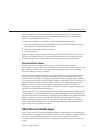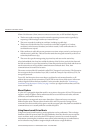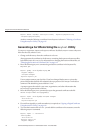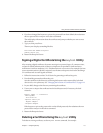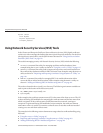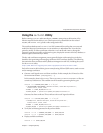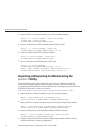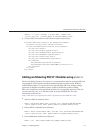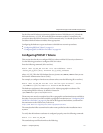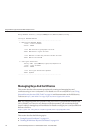
Using the certutil Utility
Before running certutil, make sure that LD_LIBRARY_PATH points to the location of the
libraries required for this utility to run. This location can be identied from the value of
AS_NSS_LIB in asenv.conf (product wide conguration le).
The certicate database tool, certutil, is an NSS command-line utility that can create and
modify the Netscape Communicator cert8.db and key3.db database les. It can also list,
generate, modify, or delete certicates within the cert8.db le and create or change the
password, generate new public and private key pairs, display the contents of the key database, or
delete key pairs within the key3.db le.
The key and certicate management process generally begins with creating keys in the key
database, then generating and managing certicates in the certicate database. The following
document discusses certicate and key database management with NSS, including the syntax
for the certutil utility:
http://www.mozilla.org/projects/security/pki/nss/tools/certutil.html.
Each of the items in the list below gives an example using NSS and JSSE security tools to create
and/or manage certicates.
■
Generate a self-signed server and client certicate. In this example, the CN must be of the
form hostname.domain.[com|org|net|...].
In this example, domain-dir/config. The serverseed.txt and clientseed.txt les can
contain any random text. This random text will be used for generating the key pair.
certutil -S -n $SERVER_CERT_NAME -x -t "u,u,u"
-s "CN=$HOSTNAME.$HOSTDOMAIN, OU=Java Software, O=Sun Microsystems Inc.,
L=Santa Clara, ST=CA, C=US"
-m 25001 -o $CERT_DB_DIR/Server.crt
-d $CERT_DB_DIR -f passfile <$CERT_UTIL_DIR/serverseed.txt
Generate the client certicate. This certicate is also a self-signed certicate.
certutil -S -n $CLIENT_CERT_NAME -x -t "u,u,u"
-s "CN=MyClient, OU=Java Software, O=Sun Microsystems Inc.,
L=Santa Clara, ST=CA, C=US"
-m 25002 -o $CERT_DB_DIR/Client.crt
-d $CERT_DB_DIR -f passfile <$CERT_UTIL_DIR/clientseed.txt
■
Verify the certicates generated in the previous bullet.
certutil -V -u V -n $SERVER_CERT_NAME -d $CERT_DB_DIR
certutil -V -u C -n $CLIENT_CERT_NAME -d $CERT_DB_DIR
■
Display available certicates.
certutil -L -d $CERT_DB_DIR
UsingNetworkSecurityServices (NSS)Tools
Chapter9 • ConguringSecurity 117



